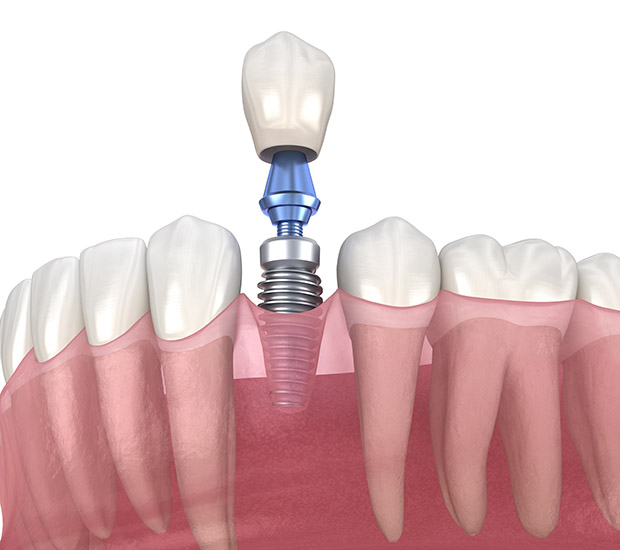Dental ImplantsOnalaska, WI
Dental implants are a form of artificial teeth. The implants are artificial roots that dental professionals can surgically implant into the jawbone. Missing teeth can wreak havoc on a person's oral health. Implants match the natural teeth and can help those dealing with tooth loss due to trauma, decay, or periodontal disease.
What are dental implants?
Implants have a high success rate. Patients who can undergo teeth extractions or oral surgeries are usually healthy enough to go through dental implants.
Dental implant types
There are two different dental implants: endosteal implants and subperiosteal implants. Patients choose endosteal implants when they still have enough healthy jawbone to support the new teeth. Endosteal implants use body-safe materials, such as titanium.
The practitioner inserts endosteal implants in the jawbone to replace the roots. An implant can anchor several teeth or only one.
Subperiosteal implants, on the other hand, must go beneath the gum but not beneath the jawbone. Practitioners place them on or above bone.
Dental implant advantages
Dentists place about 5 million dental implants every year. In fact, many people prefer dental implants.
Bone loss prevention
A person's tooth roots send signals to the jawbone to aid bone growth. Without the roots, the jawbone ceases to grow. The body begins to absorb the bone once someone loses a tooth. Unfortunately, with the loss of the jawbone, facial muscles may begin to sag too.
An implant performs the same function as a tooth's root. It encourages bone growth and preserves the shape of a patient's face.
Oral health improvement
Implants do not negatively affect a person's remaining teeth. With dental implants, patients can maintain the health of their remaining teeth while performing the same maintenance on their implants. Brushing teeth twice daily, using mouthwash, and flossing can keep the implants healthy. There are no extra steps to take; instead, they can treat the implants like their natural teeth.
Comfort and versatility
Without teeth, patients cannot speak as well. They may develop a lisp or slur. People who have issues with their speech may not speak half as much. Often, it can lead to someone feeling more socially awkward and nervous in public. The implants restore natural speech patterns and do not slip around in a person's mouth.
Dental implants feel like natural teeth. They are stable and secure and stay locked firmly in place. Most people can forget that they have them at all. Patients can have implants that replace one or many teeth.
Better nutrition
A few missing teeth can alter the way a person can eat. They have difficulty chewing different foods. Implants make chewing easy again. Without teeth, patients may have various diet restrictions. After all, when a person cannot chew, he or she may have to avoid crunchy or chewy foods. Once the patient has implants, they can focus on nutrition and taste, rather than restrictions. There are no food restrictions for dental implants.
Confidence improvement
The loss of natural teeth can lead to a drop in self-confidence. Patients may hide their smiles or speak with low confidence. The inability to show their teeth can interfere with their social and professional life. However, when a person receives implants, they no longer have to worry about the appearance of their teeth.
Extra durability
Dental implants can last a lifetime. When cared for properly, they do not have an expiration date. However, the crowns atop the implant may need replacements every 15 years. Implants are able to take the same wear and tear that natural roots do.
The implant procedure
Every dental implant procedure depends on the patient's specific circumstances. The initial healing process may take about one to two weeks, but the whole process can take as long as three to six months.
Examination
During the initial examination, dentists check the jawbone, gums, and teeth health. If a patient has a thin or soft jawbone, he or she may require a bone graft before the implant. Likewise, an approved mouth must not have periodontal disease.
Generally, dentists seek to replace one or more teeth with implants. The gravity of the procedure depends on the number of teeth to be replaced.
Implant placement
To place an endosteal implant, the practitioner has to expose the jawbone to drill holes into the bone. The professional then inserts the implants into the bone. Until a patient can receive a permanent tooth, some dentists may provide a removable denture for the aesthetic.
Osseointegration
During the implant process, the post has to combine with the bone. The osseointegration process can take from two to six months to complete. As new bone grows around the screw, it strengthens the implant. The post can only become the artificial root if the bone holds it firmly.
Abutment procedure
An abutment is a metal extender. The dentist places the abutment during either the initial or second procedure. Patients require abutments to connect replacement teeth to the implant posts.
The professional may make a new incision if the patient requires a second procedure. Practitioners place a healing cap during the first procedure to protect the implant. In the second procedure, the dentist removes the cap and screws the abutment onto the implant. Gum tissue can contour around the metal extender.
Tooth placement
It can take several weeks for the gums to heal following the abutment placement. Once healed, dentists can place the new teeth. Professionals take impressions of the teeth to fit new permanent teeth.
Patients have a choice between removable and fixed teeth. Professionals fix removable teeth to a metal frame. Patients can remove their teeth to clean them every day. Fixed teeth remain permanently; dentists can screw or cement them to the abutment.
Conclusion
Dental implants can restore a patient's smile and ability to chew and speak. Implants tend to be more durable and convenient than other options. Installing the implants depends on the number of lost teeth and the health of the patient's mouth.
Request an appointment here: https://siegertdental.com or call Siegert Dental at (608) 394-3943 for an appointment in our Onalaska office.





